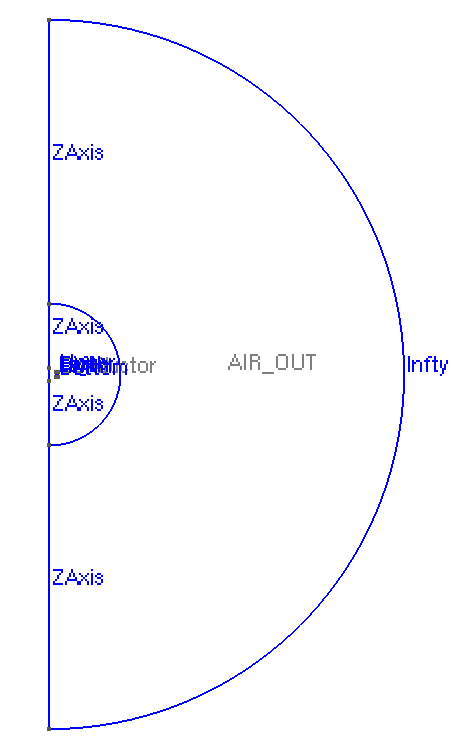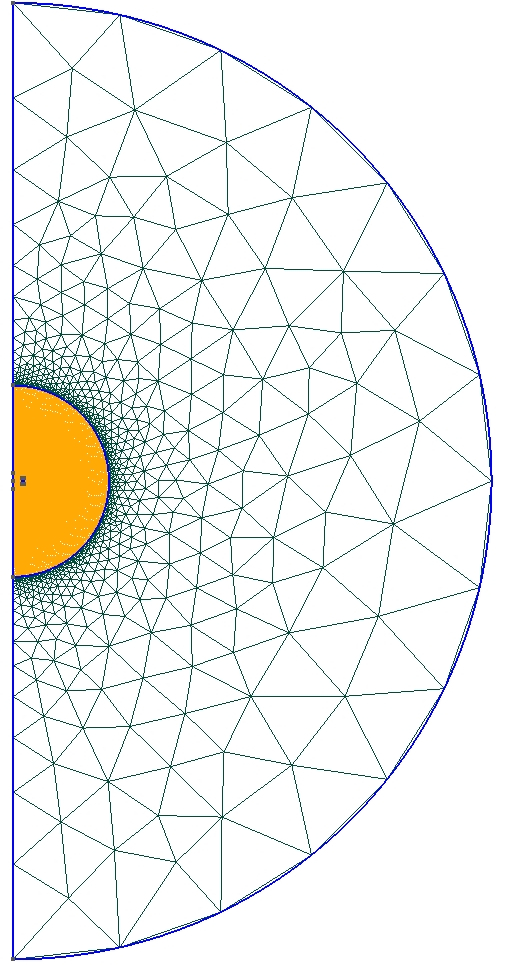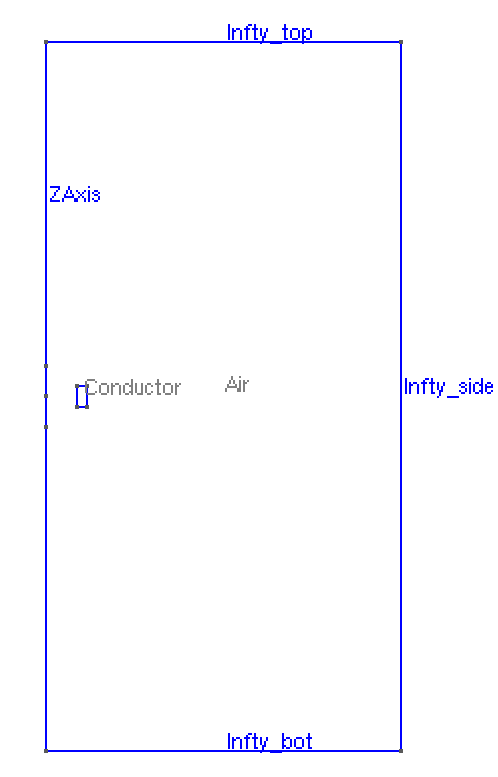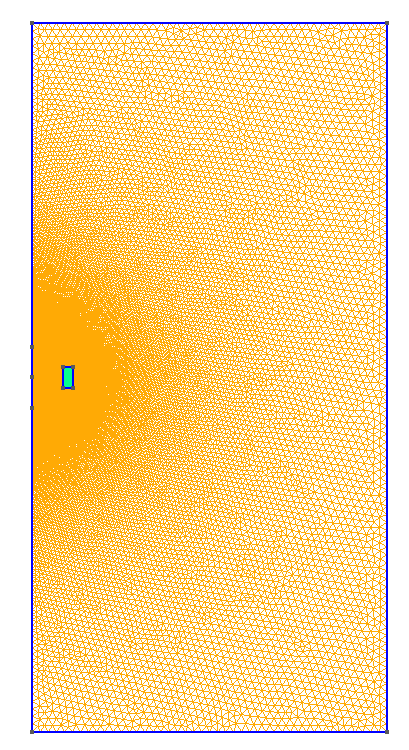Fit & AIR_OUT
In the previous case, we imposed \(A_\theta=0\) on the border infty, which gives results that are not so good near this border. The problem comes for the fact that the analytical solution for \(A_\theta\) on infty is not exactly 0. In order to overcome this problem, we wil implement two methods : fit and AIR_OUT.
1. AIR_OUT
The first method will be to add another layer of Air around the pre-existing air surrounding the conductor. The infty border is pushed back far from the place where we stop our mesurations.

Geometry with AIR_OUT
|
The Air domain contains the previous Air plus AIR_OUT. The AIR_OUT external border becomes the infty border.
Symbol |
Description |
value |
unit |
\(r_{int}\) |
interior radius of torus |
\(75e-3\) |
m |
\(r_{ext}\) |
exterior radius of torus |
\(100.2e-3\) |
m |
\(z_1\) |
half-height of torus |
\(25e-3\) |
m |
\(r_{infty2}\) |
radius of infty border |
\(5*(5*r_{ext})\) |
m |
Mesh size :
-
Interior of torus : \(0.001 m\)
-
Far from torus : \(0.004 m\)
-
Far in AIR_OUT : \(1 m\)

Mesh of Geometry
|
1.1. Run the Calculation
To run this case, the first thing to do is to change the Meshes reference to 1torus-axis2.geo in the JSON FILE - Edit the file :
"Meshes":
{
"cfpdes":
{
"Import":
{
"filename":"$cfgdir/1torus-axis2.geo"
}
}
},
The command line to run this case is :
mpirun -np 16 feelpp_toolbox_coefficientformpdes --config-file=magnetostatic.cfg --cfpdes.gmsh.hsize=1e-3
1.3. Magnetic Potential Field
h |
Without AIR_OUT |
With AIR_OUT |
\(9e-3\) |
\(2.04\%\) |
\(1.38\%\) |
\(5e-3\) |
\(1.87\%\) |
\(1.10\%\) |
\(1e-3\) |
\(1.80\%\) |
\(0.03\%\) |
\(5e-4\) |
\(1.80\%\) |
\(0.02\%\) |
Plotting \(\frac{|A^{analytic}-A^{calculated}|}{|A^{analytic}|}\) on \(O_r\) :
1.4. Magnetic Field
h |
Without AIR_OUT |
With AIR_OUT |
\(9e-3\) |
\(2.12\%\) |
\(2.09\%\) |
\(5e-3\) |
\(1.06\%\) |
\(1.00\%\) |
\(1e-3\) |
\(0.42\%\) |
\(0.13\%\) |
\(5e-4\) |
\(0.41\%\) |
\(0.05\%\) |
Plotting \(\frac{|B_z^{analytic}-B_z^{calculated}|}{|B_z^{analytic}|}\) on \(O_z\) :
2. Fit
The second method consit of imposing the analytic solutions of \(A_\theta\) on the border infty. But in order to simplify this process, we will not use a circular arc for the border but 3 sides of a rectangle :

Geometry for the torus with fits
|
The border Infty is now separated in 3 borders :
-
Infty_top: the top border of theAirdependent of \(r\) -
Infty_bot: the bottom border of theAirdependent of \(r\) -
Infty_side: the right border of theAirdependent of \(z\)
Symbol |
Description |
value |
unit |
\(r_{int}\) |
interior radius of torus |
\(75e-3\) |
m |
\(r_{ext}\) |
exterior radius of torus |
\(100.2e-3\) |
m |
\(z_1\) |
half-height of torus |
\(25e-3\) |
m |
\(r_{infty}\) |
radius of infty border |
\(5*r_{ext}\) |
m |
Mesh size :
-
Interior of torus : \(0.001 m\)
-
Far from torus : \(0.004 m\)

Mesh of Geometry
|
2.1. Run the Calculation
The command line to run this case is :
mpirun -np 16 feelpp_toolbox_coefficientformpdes --config-file=magnetostatic_fit.cfg --cfpdes.gmsh.hsize=1e-3
2.2. Data Files
The case data files are available in Github here :
-
CFG file - Edit the file
-
JSON file - Edit the file
-
GEO file - Edit the file
2.3. Parameters
In order to impose the analytical solutions on the borders, we need to use the method "fit" for each subsection of the Infty border.
We give three csv files containing the calculated analytical solutions for each subsection depending on \(r\) for Infty_top and Infty_bot and \(z\) for Infty_side.
On JSON file, the parameters are written :
"Parameters":
{
//[...]
"fit_top": {
"type":"fit",
"filename":"$cfgdir/fittop.csv",
"abscissa":"x",
"ordinate":"Atheta",
"interpolation":"P1",
"expr":"x:x"
},
"fit_bot": {
"type":"fit",
"filename":"$cfgdir/fitbottom.csv",
"abscissa":"x",
"ordinate":"Atheta",
"interpolation":"P1",
"expr":"x:x"
},
"fit_side": {
"type":"fit",
"filename":"$cfgdir/fitside.csv",
"abscissa":"y",
"ordinate":"Atheta",
"interpolation":"P1",
"expr":"y:y"
}
}
2.4. Boundary Conditions
The Dirichlet boundary conditions imposed are :
-
On
zAxis: \(A_{\theta} = 0\) -
On
Infty_top: \(A_{\theta} = fit\_top\) -
On
Infty_bot: \(A_{\theta} = fit\_bot\) -
On
Infty_side: \(A_{\theta} = fit\_side\)
On JSON file, the boundary conditions are written :
"BoundaryConditions":
{
"magnetic":
{
"Dirichlet":
{
"ZAxis":
{
"expr":"0"
},
"mybc":
{
"markers":["Infty_top"],
"expr":"fit_top:fit_top"
},
"mybc2":
{
"markers":["Infty_bot"],
"expr":"fit_bot:fit_bot"
},
"mybc3":
{
"markers":["Infty_side"],
"expr":"fit_side:fit_side"
}
}
}
},
2.6. Magnetic Potential Field
h |
Without Fits |
With Fits |
\(9e-3\) |
\(2.04\%\) |
\(0.87\%\) |
\(5e-3\) |
\(1.87\%\) |
\(0.32\%\) |
\(1e-3\) |
\(1.80\%\) |
\(0.01\%\) |
\(5e-4\) |
\(1.80\%\) |
\(0.00\%\) |
Plotting \(\frac{|A^{analytic}-A^{calculated}|}{|A^{analytic}|}\) on \(O_r\) :
2.7. Magnetic Field
h |
Without Fits |
With Fits |
\(9e-3\) |
\(2.12\%\) |
\(1.99\%\) |
\(5e-3\) |
\(1.06\%\) |
\(0.98\%\) |
\(1e-3\) |
\(0.42\%\) |
\(0.13\%\) |
\(5e-4\) |
\(0.41\%\) |
\(0.06\%\) |
Plotting \(\frac{|B_z^{analytic}-B_z^{calculated}|}{|B_z^{analytic}|}\) on \(O_z\) :
3. Comparison of the two methods
Let’s compare the results of the two methods :
3.1. Magnetic Potential Field
h |
Without AIR_OUT or Fits |
With AIR_OUT |
With Fits |
\(9e-3\) |
\(8.71956e-3\) |
\(5.88221e-3\) |
\(3.71937e-3\) |
\(5e-3\) |
\(7.93963e-3\) |
\(4.70711e-3\) |
\(1.37938e-3\) |
\(1e-3\) |
\(7.64198e-3\) |
\(1.43807e-3\) |
\(6.26038e-5\) |
\(5e-4\) |
\(7.63809e-3\) |
\(7.77611e-5\) |
\(1.51056e-5\) |
h |
Without AIR_OUT or Fits |
With AIR_OUT |
With Fits |
\(9e-3\) |
\(2.04\%\) |
\(1.38\%\) |
\(0.87\%\) |
\(5e-3\) |
\(1.87\%\) |
\(1.10\%\) |
\(0.32\%\) |
\(1e-3\) |
\(1.80\%\) |
\(0.03\%\) |
\(0.01\%\) |
\(5e-4\) |
\(1.80\%\) |
\(0.02\%\) |
\(0.00\%\) |
Plotting \(\frac{|A^{analytic}-A^{calculated}|}{|A^{analytic}|}\) on \(O_r\) :
3.2. Magnetic Field
h |
Without AIR_OUT or Fits |
With AIR_OUT |
With Fits |
\(9e-3\) |
\(15.462408e-2\) |
\(15.281730e-2\) |
\(14.544868e-2\) |
\(5e-3\) |
\(7.717275e-2\) |
\(7.331173e-2\) |
\(7.142153e-2\) |
\(1e-3\) |
\(3.074955e-2\) |
\(9.307516e-3\) |
\(9.598967e-3\) |
\(5e-4\) |
\(2.982289e-2\) |
\(3.810487e-3\) |
\(4.290458e-3\) |
h |
Without AIR_OUT or Fits |
With AIR_OUT |
With Fits |
\(9e-3\) |
\(2.12\%\) |
\(2.09\%\) |
\(1.99\%\) |
\(5e-3\) |
\(1.06\%\) |
\(1.00\%\) |
\(0.98\%\) |
\(1e-3\) |
\(0.42\%\) |
\(0.13\%\) |
\(0.13\%\) |
\(5e-4\) |
\(0.41\%\) |
\(0.05\%\) |
\(0.06\%\) |
Plotting \(\frac{|B_z^{analytic}-B_z^{calculated}|}{|B_z^{analytic}|}\) on \(O_z\) :
3.3. Conclusion
At the end, both methods give more precise results. The fit method seems to be the better one, but also the harder to implement because an analytical solution is needed, and it must be calculated on all borders before the simulation. The Air_out method is easier to implement and doesn’t need much preparation.